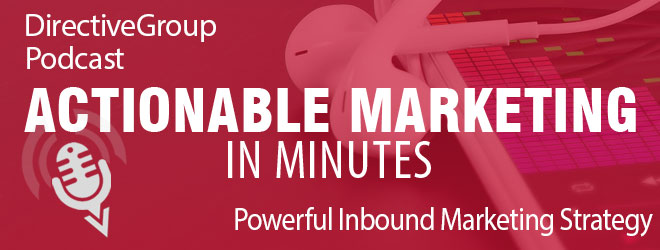In this episode of Actionable Marketing In Minutes we talk about: Marketing Audits.
Use the player below to listen to this episode, or the download link to load it on your device for listening later. You can also find our RSS feed by clicking here, or subscribing by email in the sidebar to the left.
Download our Marketing To Millennials eBook here!
Not able to listen? Why not read the episode transcript below:
Being a business owner means having to wear a lot hats at once to grow your business. It takes a lot of time and effort to deal with vendors, manage sales and constantly be on the lookout for new opportunities. In between managing your jam-packed schedule and making business critical decisions, marketing efforts are often pushed to the back burner. But if you want to see conversions and continued growth for your business over time, you need to address pain points your target audience has with a complete inbound marketing strategy. With so many channels available these days, inbound marketing is incredibly powerful. And for the same reasons, it can be intimidating. But the good news is, it is actually quite simple to get all the pieces working together if you understand the fundamentals.
Consumers no longer want to be sold to, they prefer to be educated so that they can make smart and well-informed decisions. Inbound marketing is designed around attracting audiences using personalized, relevant messaging and content that speaks directly to their needs.
Inbound marketing can be broken down into three major phases- 1. Attracting audiences, 2. Converting audience to leads, 3. Nurturing leads to sales – each phase builds off the last.
- Attracting Audiences
Different Inbound marketing techniques can be used to attract audiences, increase reach and build brand presence. Let’s look at some of the more common tactics that can be used to accomplish this:
Web Optimization– Your business website serves as the digital face of your brand and a one-stop source of information for your target audience. Optimizing your site for search by working on on-page SEO, technical SEO, improving web design usability, and creating content for conversions and lead Generation, helps search engines notice and display your website at the top of search results organically. This directs more users to find the information they need, which in turn means higher traffic for your website.
SEM– Many businesses use search engine marketing (SEM) methods like PPC or AdWords to show ads to prospects. When a search query includes specific keywords related to your product or service these paid ads are shown. It can get quick results and instant audience.
Social Media Marketing– Create business pages and social media groups in various platforms such as Facebook, LinkedIn group, Twitter and get your message out about your product or services. If your content is well received, you can easily build a large following.
Content Marketing– Your site must hold the attention of your audience. For that to happen you must create a steady stream of content to educate, problem solve, inspire or entertain your existing readers and attract new users to your site. To keep your customers engaged with your brand you need to offer different content types from blogs, ebooks, case studies, webinars, white papers, workbooks, videos and more.
- Converting Audience To Leads
Once your site starts getting more traffic, you need to focus on audience aggregation through channels such as Facebook, LinkedIn, Twitter, forums, community sites and e-mail. Capturing the attention of a group of people with similar interests makes it easier to promote your content and engage with them long-term.
You need to get into the mind of your audience and understand user behavior, key metrics and performance indicators so that you can create the right content. Then you can modify your calls-to-action and optimize landing pages; use shorter forms and smarter Thank-you pages in order to convert audiences into valuable leads.
- Nurturing Leads to Sales
To encourage leads to become customers and increase sales, you need to send out the right e-mail with the right marketing message at the right time. E-mail marketing can help in prospecting and lead scoring, nurturing and developing relationships all the way through to completing sales transactions and asking for referrals.
Benefits
Inbound marketing can help you create a voice that people love, which will ultimately help you generate and increase sales for your business. But for Inbound marketing to be applied successfully, it requires specific expertise and experience. Don’t be afraid to reach out for assistance and hire outside help!
We hope you’ve found this information helpful. Please connect with us on Twitter @DirectiveGroup or on LinkedIn. Let us know what you think and what you’d like to hear about next. And if you like our podcasts please share with your networks using hashtag #actionablemarketing.
Podcast: Play in new window | Download (Duration: 6:47 — ) | Embed
